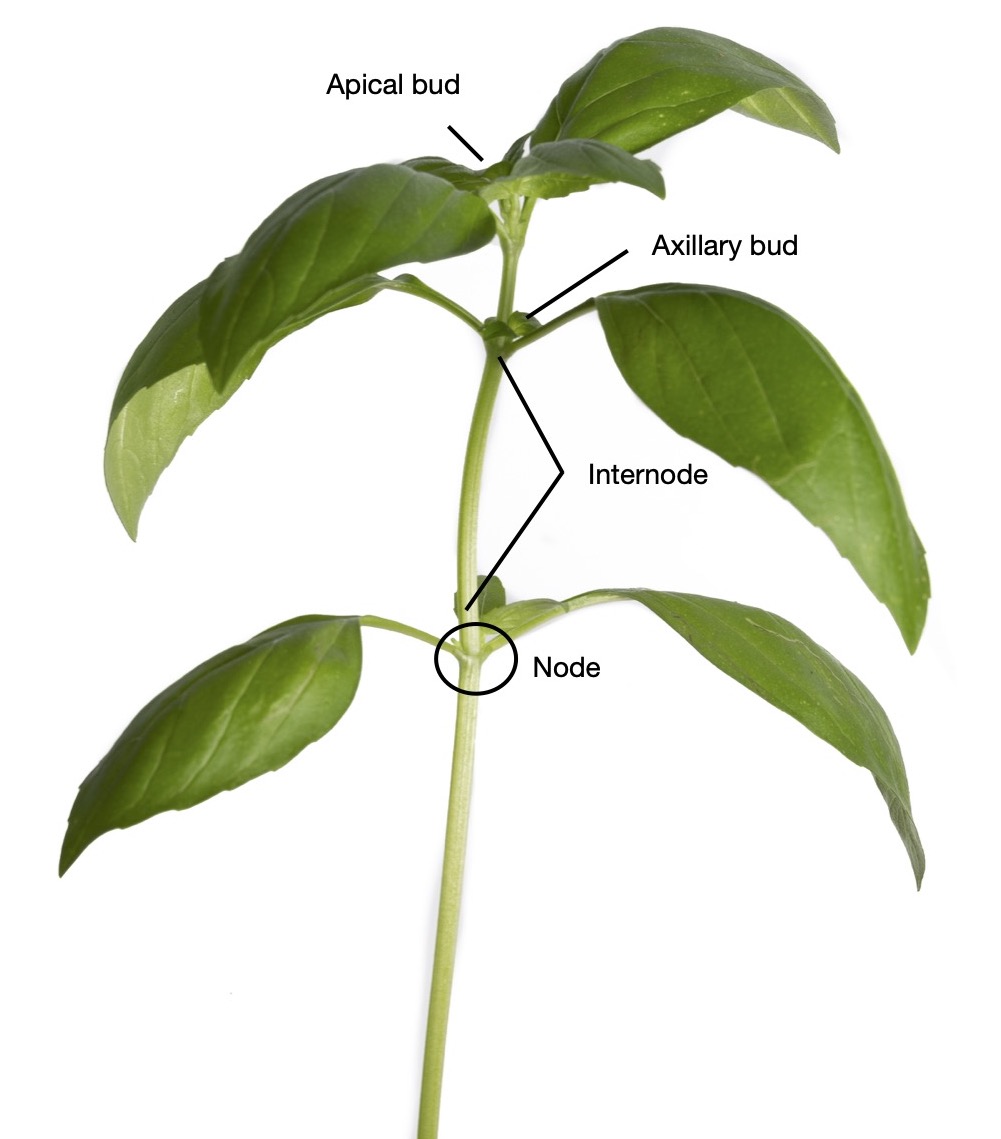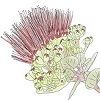3.1: Parts of the stem and primary growth
- Page ID
- 59223
\( \newcommand{\vecs}[1]{\overset { \scriptstyle \rightharpoonup} {\mathbf{#1}} } \)
\( \newcommand{\vecd}[1]{\overset{-\!-\!\rightharpoonup}{\vphantom{a}\smash {#1}}} \)
\( \newcommand{\id}{\mathrm{id}}\) \( \newcommand{\Span}{\mathrm{span}}\)
( \newcommand{\kernel}{\mathrm{null}\,}\) \( \newcommand{\range}{\mathrm{range}\,}\)
\( \newcommand{\RealPart}{\mathrm{Re}}\) \( \newcommand{\ImaginaryPart}{\mathrm{Im}}\)
\( \newcommand{\Argument}{\mathrm{Arg}}\) \( \newcommand{\norm}[1]{\| #1 \|}\)
\( \newcommand{\inner}[2]{\langle #1, #2 \rangle}\)
\( \newcommand{\Span}{\mathrm{span}}\)
\( \newcommand{\id}{\mathrm{id}}\)
\( \newcommand{\Span}{\mathrm{span}}\)
\( \newcommand{\kernel}{\mathrm{null}\,}\)
\( \newcommand{\range}{\mathrm{range}\,}\)
\( \newcommand{\RealPart}{\mathrm{Re}}\)
\( \newcommand{\ImaginaryPart}{\mathrm{Im}}\)
\( \newcommand{\Argument}{\mathrm{Arg}}\)
\( \newcommand{\norm}[1]{\| #1 \|}\)
\( \newcommand{\inner}[2]{\langle #1, #2 \rangle}\)
\( \newcommand{\Span}{\mathrm{span}}\) \( \newcommand{\AA}{\unicode[.8,0]{x212B}}\)
\( \newcommand{\vectorA}[1]{\vec{#1}} % arrow\)
\( \newcommand{\vectorAt}[1]{\vec{\text{#1}}} % arrow\)
\( \newcommand{\vectorB}[1]{\overset { \scriptstyle \rightharpoonup} {\mathbf{#1}} } \)
\( \newcommand{\vectorC}[1]{\textbf{#1}} \)
\( \newcommand{\vectorD}[1]{\overrightarrow{#1}} \)
\( \newcommand{\vectorDt}[1]{\overrightarrow{\text{#1}}} \)
\( \newcommand{\vectE}[1]{\overset{-\!-\!\rightharpoonup}{\vphantom{a}\smash{\mathbf {#1}}}} \)
\( \newcommand{\vecs}[1]{\overset { \scriptstyle \rightharpoonup} {\mathbf{#1}} } \)
\( \newcommand{\vecd}[1]{\overset{-\!-\!\rightharpoonup}{\vphantom{a}\smash {#1}}} \)
\(\newcommand{\avec}{\mathbf a}\) \(\newcommand{\bvec}{\mathbf b}\) \(\newcommand{\cvec}{\mathbf c}\) \(\newcommand{\dvec}{\mathbf d}\) \(\newcommand{\dtil}{\widetilde{\mathbf d}}\) \(\newcommand{\evec}{\mathbf e}\) \(\newcommand{\fvec}{\mathbf f}\) \(\newcommand{\nvec}{\mathbf n}\) \(\newcommand{\pvec}{\mathbf p}\) \(\newcommand{\qvec}{\mathbf q}\) \(\newcommand{\svec}{\mathbf s}\) \(\newcommand{\tvec}{\mathbf t}\) \(\newcommand{\uvec}{\mathbf u}\) \(\newcommand{\vvec}{\mathbf v}\) \(\newcommand{\wvec}{\mathbf w}\) \(\newcommand{\xvec}{\mathbf x}\) \(\newcommand{\yvec}{\mathbf y}\) \(\newcommand{\zvec}{\mathbf z}\) \(\newcommand{\rvec}{\mathbf r}\) \(\newcommand{\mvec}{\mathbf m}\) \(\newcommand{\zerovec}{\mathbf 0}\) \(\newcommand{\onevec}{\mathbf 1}\) \(\newcommand{\real}{\mathbb R}\) \(\newcommand{\twovec}[2]{\left[\begin{array}{r}#1 \\ #2 \end{array}\right]}\) \(\newcommand{\ctwovec}[2]{\left[\begin{array}{c}#1 \\ #2 \end{array}\right]}\) \(\newcommand{\threevec}[3]{\left[\begin{array}{r}#1 \\ #2 \\ #3 \end{array}\right]}\) \(\newcommand{\cthreevec}[3]{\left[\begin{array}{c}#1 \\ #2 \\ #3 \end{array}\right]}\) \(\newcommand{\fourvec}[4]{\left[\begin{array}{r}#1 \\ #2 \\ #3 \\ #4 \end{array}\right]}\) \(\newcommand{\cfourvec}[4]{\left[\begin{array}{c}#1 \\ #2 \\ #3 \\ #4 \end{array}\right]}\) \(\newcommand{\fivevec}[5]{\left[\begin{array}{r}#1 \\ #2 \\ #3 \\ #4 \\ #5 \\ \end{array}\right]}\) \(\newcommand{\cfivevec}[5]{\left[\begin{array}{c}#1 \\ #2 \\ #3 \\ #4 \\ #5 \\ \end{array}\right]}\) \(\newcommand{\mattwo}[4]{\left[\begin{array}{rr}#1 \amp #2 \\ #3 \amp #4 \\ \end{array}\right]}\) \(\newcommand{\laspan}[1]{\text{Span}\{#1\}}\) \(\newcommand{\bcal}{\cal B}\) \(\newcommand{\ccal}{\cal C}\) \(\newcommand{\scal}{\cal S}\) \(\newcommand{\wcal}{\cal W}\) \(\newcommand{\ecal}{\cal E}\) \(\newcommand{\coords}[2]{\left\{#1\right\}_{#2}}\) \(\newcommand{\gray}[1]{\color{gray}{#1}}\) \(\newcommand{\lgray}[1]{\color{lightgray}{#1}}\) \(\newcommand{\rank}{\operatorname{rank}}\) \(\newcommand{\row}{\text{Row}}\) \(\newcommand{\col}{\text{Col}}\) \(\renewcommand{\row}{\text{Row}}\) \(\newcommand{\nul}{\text{Nul}}\) \(\newcommand{\var}{\text{Var}}\) \(\newcommand{\corr}{\text{corr}}\) \(\newcommand{\len}[1]{\left|#1\right|}\) \(\newcommand{\bbar}{\overline{\bvec}}\) \(\newcommand{\bhat}{\widehat{\bvec}}\) \(\newcommand{\bperp}{\bvec^\perp}\) \(\newcommand{\xhat}{\widehat{\xvec}}\) \(\newcommand{\vhat}{\widehat{\vvec}}\) \(\newcommand{\uhat}{\widehat{\uvec}}\) \(\newcommand{\what}{\widehat{\wvec}}\) \(\newcommand{\Sighat}{\widehat{\Sigma}}\) \(\newcommand{\lt}{<}\) \(\newcommand{\gt}{>}\) \(\newcommand{\amp}{&}\) \(\definecolor{fillinmathshade}{gray}{0.9}\)Stems play a huge role in our lives, as they have a vast range of uses, such as food, fuel, shelter, construction materials, furniture, light poles, musical instruments, and raw materials for a vast variety of paper products (paper towels, toilet paper, writing paper). One of the most important sources of carbohydrates worldwide is potatoes (Solanum tuberosum), which are a type of modified stem (tuber). Potatoes were first domesticated in South America about 8,000 -10,000 years ago and were taken to Europe in the 16th century. It is now cultivated worldwide and many cultures have incorporated it into their cuisines. In the Pacific many island nations cultivate taro/kalo (Colocasia esculenta), a modified stem called corm, which originated in China and migrated with people throughout the Pacific.
Stem anatomy
Stems are the vertical structures of plants where leaves attach. They are usually found above ground, providing mechanical support, conducting water and nutrients, and sometimes storing food. Stems can be woody (e.g. koa tree) or herbaceous (e.g. tomato), they can be tall as in sequoias (75 meters or 245 feet), or short as in ʻilima papa (12 cm or 5 inches); wide as in some cypress trees (11.5 meters or 36 feet) or thin as in sunflowers (2 meters or 6 feet).
In most woody flowering plants we can recognize nodes and internodes as the basic parts of the stem (Figure \(\PageIndex{1}\)). The nodes are the places where leaves attach to the stem, while internodes are the spaces between the nodes.

Internal parts of the stem
Some stems are woody and some stems are herbaceous, which will define the type of tissues present inside of them. Monocots always have herbaceous stems, while eudicots can have herbaceous or woody stems. In both groups, the vascular tissue is arranged in bundles (vascular bundles), a region where you have both xylem and phloem grouped next to each other, and these bundles are surrounded by ground tissue, which is composed of cells called parenchyma. The organization of the vascular bundles is an identifying characteristic in monocots and eudicots. In monocots, like corn, these vascular bundles are scattered throughout the stem tissue. If you were to take a closer look at each vascular bundle in monocots, you will see alien faces, with big eyes (Figure \(\PageIndex{2}\)). So if you are in the microscope and you find cute alien faces staring back, you know you are looking at a monocot stem. Eudicots, like beans and mango trees, are a little more complex. Eudicot stems can be herbaceous or woody. In herbaceous or young woody eudicots the vascular bundles are arranged in a ring fashion around the stem (Figure \(\PageIndex{2}\)) and there are no cute alien faces on them. In older stems these bundles tend to fuse to form concentric rings.
Primary growth
Stems grow vertically and, similarly to roots, they have meristematic tissue on their tips, where cells are constantly dividing through mitosis, allowing the stem to elongate. This growth in length is called primary growth. Some plants can grow indefinitely for their entire lives, even for thousands of years. However, the rate of growth varies from plant to plant and it also depends on the environmental conditions where the plant is growing. Some plants can grow really fast, like albizia (Falcataria moluccana), an invasive species in Hawai‘i, which can grow 4.5 meters (15 feet) per year (Little and Skolmen, 1989). Other plants grow very slowly, like the bristlecone pine trees in California, where a 5,000-year-old tree can measure just 18 meters (60 feet). Similarly, in Hawai‘i, some oʻhiʻa lehua (Metrosideros polymorpha) trees are very short (30 centimeters or 12 inches) but can be as old as 300 years.
The meristem found on the tip of a stem is called the apical or terminal meristem, and it receives this name because it is located at the apex or end of the stem. In the stem, we also find meristematic tissue in the nodes, specifically in a little rounded bump found above the place of leaf attachment. They are called axillary buds and are found in the angle formed between the leaf stalk (petiole) and the stem (Figure \(\PageIndex{1}\)). These buds are protected by bud scales, and they can become branches, flowers, or new leaves. Each new branch will develop its own apical meristem, ensuring that each branch can grow independently.


